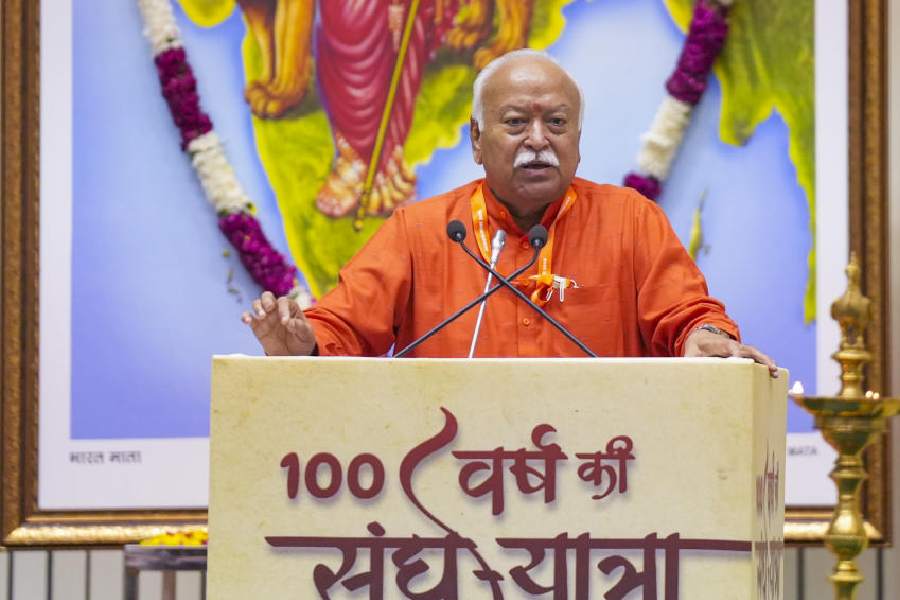 |
 |
 |
| (From top): Monastiraki Square; a view of Acropolis Hill, with the Erechtheion in the foreground; the Parthenon in all its scaffolded glory |
If it weren’t for the Parthenon dominating the Athens’ skyline, my Greek odyssey would have begun badly indeed. We were standing in Monastiraki Square, which my guidebook had said was one of the most happening parts of the city. But all I saw at first were dirty buildings and the McDonalds selling pita wrap combos. On all sides were impossibly narrow lanes brimming with touristy shops and restaurants whose tables spilt on to the middle of the road, where they jostled with tables of rival restaurants across the lane.
Then the haunting notes of pipes wafted across the square. A Peruvian band had begun playing their native music to a crowd. It somehow managed not to sound too alien in that almost Asian bustle, and we realised that this was where Athens’ charm lay ? this ancient city was a lot more cosmopolitan than it looked. The dingy buildings soon faded into the twilight, and all one could really see was the Parthenon, majestically lit up on top of the Acropolis hill. In the darkness, as the music washed over us, and the ouzo washed down the greasy gyros and pita we had for dinner, it was as if we were seeing Monastiraki Square for the first time.
In the few days we spent in Greek capital, we got this same sense of Eastern flavours blending with Western sensibilities, wherever we went. “These narrow lanes remind me of Istanbul’s Grand Bazaar,” I commented to the concierge of our pension. “That’s not surprising,” he said, “since most of the shops there are owned by Turks!” Apparently a huge number of Turks settled in Greece decades ago ? part of some forced population exchange programme. Besides Turks, we also met Iranians, Arabs, all sorts of Europeans ? even Russians, all trying to make a living there. “I spikking no English,” said the Iranian waiter in a restaurant to us, “you Indian?” We nodded. “Hindi movies ...mmm!” he said, “I love that tall, dark hero ? what’s his name?” My husband and I replied in unison, “Amitabh Bachchan.” “No”, he said, kissing his fingers, “the other one, the one who’s the better dancer.” We were stumped. “I got it,” he cried, moving his pelvis in an eerily familiar dance step. “Mithun Chakravarty!” The next 10 minutes, he raved about the actor in a crazy mix of Greek, Iranian, English and a few words of Hindi. I asked if he’d seen Amitabh’s films. “Yes,” he said, “but Mithun’s are better!”
Public transport in Athens is very well organised ? the metro’s great, as are the buses, which connect the city to its port, Piraeus, and airport. But Athens’ truest pleasure was its walks, for most of its key sights are linked by traffic-free walkways. It’s part of an ambitious project to make pedestrian zones all the way up to the Olympic Stadium which, in 1896, hosted the first modern Olympic Games. The three central squares other than Monastiraki ? Syntagma, Omonia and Kolonaki, also have walkers’ zones.
The best walk, of course, was around the base, and upwards of Acropolis Hill. This area, Plaka, was peppered with shops, restaurants, caf?s and historical sites. In 1834, this was all that Athens comprised of. Over the years, Plaka has retained some of its old buildings though many have crumbled into oblivion. We walked there early morning, in not much of a hurry to make the climb up to the Parthenon. We saw droves of tourists descending from buses, and realised our mistake. For there was a serpentine queue moving ahead, all the way up to the temple of Athena Nike, abode of the winged victory and the entrance to the Acropolis complex.
The view was fantastic. It was easy to see why the Acropolis hill had been inhabited as early as 5000 BC. Its sheer sides and height made it a superb natural defense against invaders coming from across the sea, as well as from the plains of Attica. Everything about the complex was huge and evocative of history ? in spite of the fact that massive conservation efforts were underway, and much of the structures were obscured by scaffolding.
Once past the Prophylia, the 5th century BC gate that leads into the complex, the most engaging structure was the Erechtheion, tomb of the legendary king of Athens. Instead of pillars, its ceilings were supported by six kores, (maidens). It also has, the legend goes, a hole in its ceiling and floor where Poseidon’s spear struck, during his quarrel with Athena about who should be the patron deity of Athens. His spear brought forth a spring of sweet water, to which Athena responded by bringing forth an olive tree, symbolising control over the rich plains of Attica. She won, incidentally, and that’s how Athens got its name.
The Parth enon’s been copied ad nauseum by so many architects ? but we were still unprepared for its size and grandeur. Sadly, we weren’t allowed to enter, or go close enough to appreciate its friezes. But then we took solace from the fact that even in its heyday, the Parthenon wasn’t open to the hoi polloi ? only high priests and kings were allowed in to pay homage to the statue of Athena made by the great sculptor Phidias. Nothing remains of the statue today, except for millions of truly horrible prints on everything from mugs to t-shirts.
On our way down, we passed the remains of the ancient agora, marketplace, and reached the temple of Hephaistos. Compared to the piles of rubble around it, it was in mint condition, but we were struck by how graceful the Parthenon looked in comparison. This is because Iktinos, the architect of the Parthenon, was a master of optical illusions. He designed the external columns of the temple to be thicker in the middle, creating the illusion that the column was absolutely straight. The Parthenon, with 17 columns on each side and 8 on each end, looked much more proportionate than this temple, which had only 13 columns on each side, and 6 on each end.
A shudder passed through the Agora, and for a minute I feared it was an earthquake. Then I saw it was a train ? apparently, some ruins in the Agora had been sacrificed to accommodate Athens’ state-of-the-art metro. I sat on a pile of stones that had undoubtedly once served a better purpose, watching the trains pass with a Teutonic regularity, thinking that it was only fitting that in this city of contrasts, the old and the new could co-exist with so little fuss.
Photographs by the author
Just passing through
 |
 |
 |
| (From top): The Dubai International Airport; a duty free shop at Bangkok International Airport; and passengers in transit at Hong Kong International Airport |
Once upon a time an airport was a place where you raced in and caught a flight — and nothing more. Today the world’s most modern airports are mini-cities where passengers do anything from surfing the net to catching a movie. And, if that doesn’t catch your fancy you could have a coffee or cocktail or step out for a spot of sightseeing (rent a car and mobile too). The kids can, in the meanwhile, do their own thing at entertainment areas meant solely for them.
We chart a route through Asia from Dubai to Hong Kong to see what makes these airports great during layovers.
Dubai International Airport
The smart Sheikh Rashid Terminal is the jewel in the Middle Eastern crown, — very hi-tech, very swanky, like the city itself.
What to do: Frankly, just shopping. It’s here that the world’s best products converge. The golden palm tree in the middle of its shopping mall is its signature. When you can tear yourself away from the glitter of 24-carat pure gold at the gold counters, head for the shops where everything from high-end electronics, computers and luxury brands vie for attention. Prices can be considered a bargain (that is, if you are not buying clothes and sports goods). If you are lucky and there’s a promotion on, you may just win a luxury car.
But if you want to skip the shopping, then transit passengers stopping for over five hours are entitled to a transit visa to take a tour of the city which costs between Dh. 95 and Dh. 115 (Rs 1,130 - Rs 1,369). The transit hotel offers rooms on an hourly basis and has a health club and other regular hotel facilities.
Singapore’s Changi Airport
Its two terminals could hold a smallish city! And efficient Changi is a foretaste of the rest of Singapore.
What to do: Transit passengers who have five or more hours to kill can take off for a city tour — for free. A tiring tour calls for foot reflexology or a relaxing massage at Shower, Fitness & Lifestyle and costs between S$10 and S$15 per hour (Rs 260 - Rs 390). For foodies, the airport has a host of restaurants, cafés and food courts right from a sushi bar to Burger King.
Though a tad expensive, it’s a great place for picking up garments (check out the Nike and Versace showrooms), perfumes, cosmetics, cigars, digital cameras and accessories for your computer and palm-top. Warning: you might get these cheaper at other airports.
Where to stay: The airport has 73 transit hotel rooms in Terminal 1 and another 73 in Terminal 2. You do not have to clear immigration to get to the hotels. A six-hourly rental will just set you back between S$56 to S$64 (Rs 1,456 - Rs 1,664). Saunas and gyms at your disposal, gratis.
Bangkok International Airport
It’s the hub for Thailand and South-East Asia but not in the big league of airports.
What to do: Take a guided city tour, but at your own risk as Bangkok’s traffic jams are the stuff of legends. Depending on how much time you have in-between flights, tours could last anywhere from three to five hours and cost between Baht 600 and Baht 800 (Rs 600 - Rs 800). You could head for Bangkok’s temples and palaces, the exotic night markets, hit the shops, visit the handicrafts centre or take a boat trip.
But hang on at the airport to pick up some of the best bargains at its duty free areas. Look for jade jewellery, Thai handicrafts and silk, maybe the usual camera, handycam, watch trio. And don’t forget those beautifully packed orchids before boarding your next flight.
Where to stay: Around a hundred day rooms are available at both terminals on a four-hourly basis. But if there’s nothing better on the agenda, then the transit lounge has a salon where you can opt for a Thai massage while the kids take over the play area dedicated to them.
Kuala Lumpur International Airport
For the first-time traveller to the country, the airport comes as a complete surprise. You don’t expect the lush greenery or ultra-modern look. If the airport’s area includes the Formula 1 race track, information kiosks in terminals have touch-screens that seem to be everywhere.
What to do: To begin with, just absorb your surroundings, wander around the facility and be surprised by the tropical greenery that seems to surround the airport. You’ll also enjoy the ride on the aerotrain between the terminal and the duty free area. Once there, browse around for the duty free shops have enough to buy. If you have over six hours, avail of the half-day sight-seeing tour by the Traveller’s Service Centre.
Where to stay: The Airside Transit Hotel has it all —a snack bar, spa and business centre. Even if you choose not to stay, you can use the gym, spa and sauna before you board again.
Hong Kong International Airport
A while ago landing at the airport was the first thrill as you cruised low several miles over the city to Kai Tak Airport. But the new airport has certainly more on its menu and is a state-of-the-art traveller’s paradise.
What to do: With more than four hours to spare, go for a city tour. Or hop on to the Airport Express train that’ll take you to the city in 23 mins. You could also opt for the Hong Kong transit tour, the Hong Kong island orientation tour or the Lantau island and monastery tour.
Back at the airport, look for its serious pampering facilities. The hair and beauty salon has everything from manicures to massages. Passengers also book themselves at the relaxation lounge to take a nap or just freshen up. The Oriental massage centre offers herbal remedies and massages. So next time you make a pit-stop you can safely slip into your gymwear.
My favourite holiday
 |
Amrita Arora,
actress
My work makes me travel all the time but of all the places I’ve been to, my favourite holiday spots are Goa and London. Goa, because it is beautiful and has the beach and is just 40 minutes from Mumbai by air. And London, because it is also beautiful and a melting pot with people from all over the world. I just went to London a month back. When I’m there, I usually shop, go to restaurants, clubs and pubs, and of course, Hyde Park. The English countryside too, is absolutely gorgeous — I’ve been to Leicester, Nottingham, Derby and Wales. Holidays usually mean relaxing, eating well, and walking on the streets because I don’t like to be a tourist but to mingle and be part of the place that I visit.
Route map
• Fancy a trip to Sri Lanka and Thailand? Mumbai-based Sachinam Holidays is offering a seven-day, six-night package to Colombo, Bangkok and Pattaya for Rs 18,888 per person on a twin-sharing basis. Apart from return airfare on Sri Lankan Airlines and stay at three-star hotels, the package includes daily breakfast, airport transfers, a half-day city and temple tour of Bangkok and the Coral Island tour at Pattaya.
Or check out the six-night, seven-day package to Colombo and Maldives for Rs 37,777 (twin-sharing). This includes two nights at the five-star Hotel Trans Asia at Colombo and four nights in a deluxe bungalow at the five-star Kurumba Resort at Maldives. Apart from return airfare and stay, the package includes daily breakfast and dinner, airport transfers, one glass-bottom boat ride a day, unlimited snorkeling, and one food and beverage coupon worth $50. These offers are valid till September 30. Contact: 022-2366 8343/45.
• Those of you who scour the Net for deals, here’s a spot of good news. Five-year-old makemytrip.com, the on-line Indian travel agency that has so far focused on bringing travelers from the US to India, has now turned its eye on the Indian market through its India travel site. The website, makemytrip.com (the URL for the US and Indian markets remains the same), is offering on-line booking of tickets on all airlines, some 350 hotels in the country, car rentals, weekend packages and road trips within and from India. The Website is hard-selling its Lowest Airfare Guarantee (valid on all domestic airlines including low cost carriers) that challenges the passenger (at the time of booking the ticket) to come up with a lower fare than the one offered by it. If the passenger does, then the site promises to return the passenger the difference. The search engine on the site called FarePundit offers a variety of itineraries. The site also offers the Road-Trip section.










